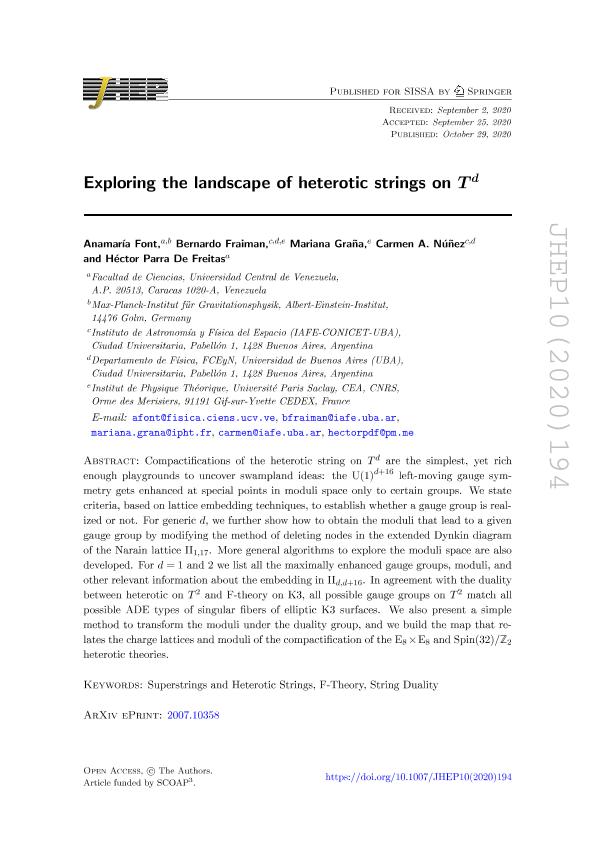Mostrar el registro sencillo del ítem
dc.contributor.author
Font, Anamaría
dc.contributor.author
Fraiman, Bernardo

dc.contributor.author
Graña, Mariana
dc.contributor.author
Nuñez, Carmen Alicia

dc.contributor.author
De Freitas, Héctor Parra
dc.date.available
2022-07-19T18:31:51Z
dc.date.issued
2020-10
dc.identifier.citation
Font, Anamaría; Fraiman, Bernardo; Graña, Mariana; Nuñez, Carmen Alicia; De Freitas, Héctor Parra; Exploring the landscape of heterotic strings on T d; Springer Science and Business Media Deutschland GmbH; Journal of High Energy Physics; 2020; 10; 10-2020; 1-75
dc.identifier.issn
1029-8479
dc.identifier.uri
http://hdl.handle.net/11336/162577
dc.description.abstract
Compactifications of the heterotic string on Td are the simplest, yet rich enough playgrounds to uncover swampland ideas: the U(1)d+16 left-moving gauge symmetry gets enhanced at special points in moduli space only to certain groups. We state criteria, based on lattice embedding techniques, to establish whether a gauge group is realized or not. For generic d, we further show how to obtain the moduli that lead to a given gauge group by modifying the method of deleting nodes in the extended Dynkin diagram of the Narain lattice II1,17. More general algorithms to explore the moduli space are also developed. For d = 1 and 2 we list all the maximally enhanced gauge groups, moduli, and other relevant information about the embedding in IId,d+16. In agreement with the duality between heterotic on T2 and F-theory on K3, all possible gauge groups on T2 match all possible ADE types of singular fibers of elliptic K3 surfaces. We also present a simple method to transform the moduli under the duality group, and we build the map that relates the charge lattices and moduli of the compactification of the E8 × E8 and Spin(32)/ℤ2 heterotic theories.
dc.format
application/pdf
dc.language.iso
eng
dc.publisher
Springer Science and Business Media Deutschland GmbH
dc.rights
info:eu-repo/semantics/openAccess
dc.rights.uri
https://creativecommons.org/licenses/by-nc-sa/2.5/ar/
dc.subject
F-THEORY
dc.subject
STRING DUALITY
dc.subject
SUPERSTRINGS AND HETEROTIC STRINGS
dc.subject.classification
Física de Partículas y Campos

dc.subject.classification
Ciencias Físicas

dc.subject.classification
CIENCIAS NATURALES Y EXACTAS

dc.title
Exploring the landscape of heterotic strings on T d
dc.type
info:eu-repo/semantics/article
dc.type
info:ar-repo/semantics/artículo
dc.type
info:eu-repo/semantics/publishedVersion
dc.date.updated
2021-08-27T20:47:16Z
dc.journal.volume
2020
dc.journal.number
10
dc.journal.pagination
1-75
dc.journal.pais
Alemania

dc.description.fil
Fil: Font, Anamaría. Max-Planck-Institut f¨ur Gravitationsphysik; Argentina. Universidad Central de Venezuela; Venezuela
dc.description.fil
Fil: Fraiman, Bernardo. Universidad de Buenos Aires; Argentina. Universite Paris-saclay; Francia. Consejo Nacional de Investigaciones Científicas y Técnicas. Oficina de Coordinación Administrativa Ciudad Universitaria. Instituto de Astronomía y Física del Espacio. - Universidad de Buenos Aires. Facultad de Ciencias Exactas y Naturales. Instituto de Astronomía y Física del Espacio; Argentina
dc.description.fil
Fil: Graña, Mariana. Universite Paris-saclay; Francia
dc.description.fil
Fil: Nuñez, Carmen Alicia. Universidad de Buenos Aires; Argentina. Consejo Nacional de Investigaciones Científicas y Técnicas. Oficina de Coordinación Administrativa Ciudad Universitaria. Instituto de Astronomía y Física del Espacio. - Universidad de Buenos Aires. Facultad de Ciencias Exactas y Naturales. Instituto de Astronomía y Física del Espacio; Argentina
dc.description.fil
Fil: De Freitas, Héctor Parra. Universidad Central de Venezuela, Facultad de Ciencias; Venezuela. Universidad Central de Venezuela; Venezuela
dc.journal.title
Journal of High Energy Physics

dc.relation.alternativeid
info:eu-repo/semantics/altIdentifier/doi/http://dx.doi.org/10.1007/JHEP10(2020)194
dc.relation.alternativeid
info:eu-repo/semantics/altIdentifier/url/https://link.springer.com/article/10.1007/JHEP10(2020)194
Archivos asociados
